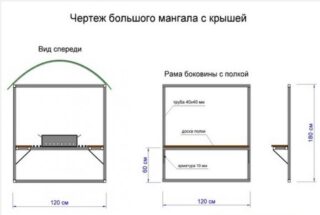On the grill, even the simplest one, ordinary sausages and sausages come out much tastier. However, the effectiveness of the open model depends on the weather: in rain or strong wind, cooking is very difficult. A brazier with a metal roof is much more convenient.
Benefits of a barbecue with a roof
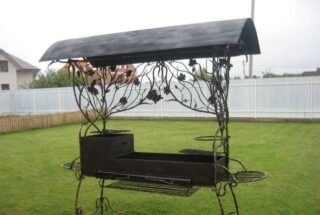
Advantages of the closed model:
- you can use the barbecue at any time of the year:
- the food being prepared is protected from rain and snow;
- a closed barbecue dissipates heat less, so less fuel is needed for cooking;
- the metal of the body and roof is covered with powder paint, which makes the product insensitive to corrosion;
- the brazier is equipped with additional devices: a support for logs, a table top, a lid.
There are also disadvantages:
- the cost of the barbecue is quite high, especially if this model is decorated with forged elements;
- the structure is heavy, most often it is impossible to move it from place to place.
They produce simple models - only for grilling - and include additional sections: with a hob, with a barbecue, with a stove.
It is not so difficult to create a homemade barbecue. However, this requires the ability to work with a welding machine, since assembly on bolts is excluded. You can facilitate the task by using improvised items - a metal box, a visor.
Before calculating and designing the drawing, it is necessary to determine where the summer cottage barbecue will be located - on the street or on the terrace, in the gazebo. The dimensions of the latter are much smaller and the roof has a different structure.
The main types of barbecues with a roof
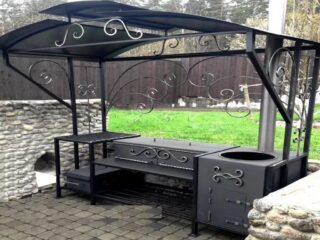
Classify structures by type of installation.
- Stationary - the canopy frame is embedded in a concrete area or racks are driven into the ground. This option is large in size, usually includes additional devices.
- Portable - lighter and smaller. Its main drawback is the windage of the lid. In strong winds, there are risks of overturning the entire structure. To compensate for the windage, the frame is placed on long metal corners and bolted. The larger the roof, the longer the corner should be.
The portable version is collapsible. Such a structure is dismantled for the winter and transferred to the house.
Distinguish between models and functionality:
- with a hob - usually for 1 burner;
- with countertops - made of metal or wood;
- with a cauldron - cast iron;
- with a stove and an oven - the latter is a separate compartment with a door and a chimney.
Almost all models are equipped with food racks. The countertop version assumes the presence of 1 or 2 blocks with legs and a solid top.
materials used
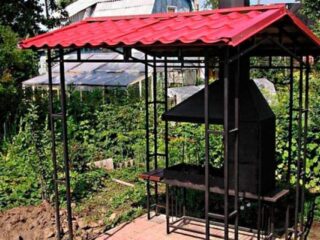
Homemade grill with a roof is made only of metal. Polycarbonate, slate, roof tiles cannot be used. The main task of the roof is to protect the brazier from rain and wind, but it conducts heat to some extent.
The following materials are used:
- Galvanized iron - corrosion resistant, durable, not afraid of the sun. For the roof, a sufficiently thin sheet of metal is taken, which allows it to be bent under almost any radius. Making an arched roof out of it is easy.
- Black iron - often combined with forged products. Black iron needs protection: it is primed, coated with a protective varnish. It is not recommended to paint - it looks clumsy.
- Profiled sheet - cheap, easy to install, durable due to its specific configuration.The roof is made like a visor, although it is allowed to bend the corrugated board.
If the barbecue is large enough and the roof is high, a chimney is not needed. If the model is small and the flooring acts as a hood, a chimney must be installed.
Preparing to create a structure
Preparation for making a brazier with a roof with your own hands comes down to calculations, the development of a drawing and the choice of material.
- For work, you will need a sheet of steel with a thickness of 0.4-0.6 mm, a metal profile, metal nets, iron handles and a couple of fireclay bricks.
- When developing a project, it is recommended to complete a drawing of each part, as well as the entire structure. This will help to correctly calculate the amount of materials.
- Mark out the details on a sheet of steel. The dimensions of each element are increased by 3-5 cm for a butt joint.
- Cut out the workpieces with a hacksaw for metal or a grinder with a disc for metal.
If necessary, bend metal sheets or profiled sheets for a canopy in advance.
DIY making
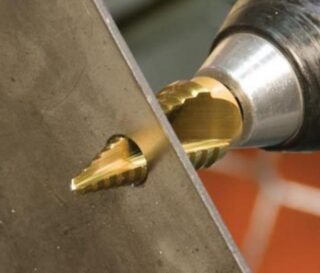
The assembly is simple, but you need to know how to work with the welding machine.
- A box is welded from the walls and bottom - a brazier. For the bottom, use a mesh or a solid sheet of metal, but with pre-drilled holes.
- Collect the frame of the barbecue. If this is a stationary model, recesses are dug at the corners of the projection of the structure on the ground, the ends of the racks are treated with bitumen, installed in the recesses and poured with concrete.
- The body is welded to the frame. At a height of 15 cm, the racks are fastened with a crossbar: here you can later leave firewood.
- In the longitudinal walls, holes are drilled for supplying oxygen - 5 pieces with a step of 10 cm on each side. If the bottom of the brazier is made of mesh, fireclay bricks are laid here: it ensures an even distribution of heat.
- Handles are welded on the ends of the box.
- Fix the flooring. The roof can be bolted.
If this is a decorative model, the forged parts are fixed last.
Additional structural elements
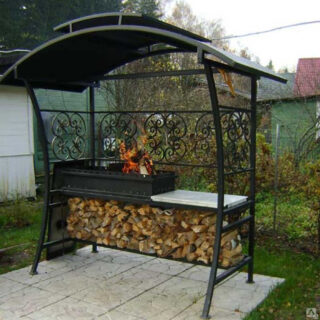
Most often, a brazier with a roof has functional additions:
- firebox - not only in the form of a shelf, but also in the form of an arched stand, basket;
- lattices for ready-made meals, semi-finished products, dishes;
- open and closed shelves for dishes and equipment;
- cauldron, hob, other cooking devices.
A brazier with a roof is more convenient and practical than an open version. The canopy protects the brazier from rain and wind. A collapsible or stationary brazier can be made independently.

